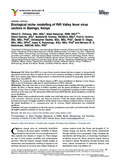| dc.contributor.author | Ochieng, AO | |
| dc.contributor.author | Nanyingi, M | |
| dc.contributor.author | Kipruto, E | |
| dc.contributor.author | Ondiba, IM | |
| dc.contributor.author | Amimo, FA | |
| dc.contributor.author | Oludhe, C | |
| dc.contributor.author | Olago, DO | |
| dc.contributor.author | Nyamongo, IK | |
| dc.contributor.author | Estambale, BB | |
| dc.date.accessioned | 2017-05-12T12:38:30Z | |
| dc.date.available | 2017-05-12T12:38:30Z | |
| dc.date.issued | 2017 | |
| dc.identifier.citation | Infect Ecol Epidemiol. 2016 Nov 17;6:32322. doi: 10.3402/iee.v6.32322. eCollection 2016. | en_US |
| dc.identifier.uri | https://www.ncbi.nlm.nih.gov/pubmed/27863533 | |
| dc.identifier.uri | http://hdl.handle.net/11295/100897 | |
| dc.description.abstract | BACKGROUND:
Rift Valley fever (RVF) is a vector-borne zoonotic disease that has an impact on human health and animal productivity. Here, we explore the use of vector presence modelling to predict the distribution of RVF vector species under climate change scenario to demonstrate the potential for geographic spread of Rift Valley fever virus (RVFV).
OBJECTIVES:
To evaluate the effect of climate change on RVF vector distribution in Baringo County, Kenya, with an aim of developing a risk map for spatial prediction of RVF outbreaks.
METHODOLOGY:
The study used data on vector presence and ecological niche modelling (MaxEnt) algorithm to predict the effect of climatic change on habitat suitability and the spatial distribution of RVF vectors in Baringo County. Data on species occurrence were obtained from longitudinal sampling of adult mosquitoes and larvae in the study area. We used present (2000) and future (2050) Bioclim climate databases to model the vector distribution.
RESULTS:
Model results predicted potential suitable areas with high success rates for Culex quinquefasciatus, Culex univitattus, Mansonia africana, and Mansonia uniformis. Under the present climatic conditions, the lowlands were found to be highly suitable for all the species. Future climatic conditions indicate an increase in the spatial distribution of Cx. quinquefasciatus and M. africana. Model performance was statistically significant.
CONCLUSION:
Soil types, precipitation in the driest quarter, precipitation seasonality, and isothermality showed the highest predictive potential for the four species. | en_US |
| dc.language.iso | en | en_US |
| dc.publisher | University of Nairobi | en_US |
| dc.rights | Attribution-NonCommercial-NoDerivs 3.0 United States | * |
| dc.rights.uri | http://creativecommons.org/licenses/by-nc-nd/3.0/us/ | * |
| dc.subject | Baringo County; Rift Valley fever; climate change; ecological niche modelling | en_US |
| dc.title | Ecological niche modelling of Rift Valley fever virus vectors in Baringo, Kenya. | en_US |
| dc.type | Article | en_US |



